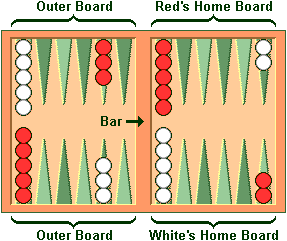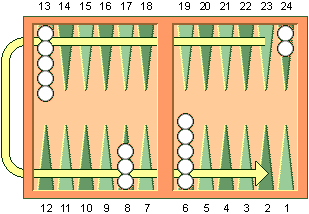How To Set Up For Backgammon

| Setup | ||
| Backgammon is a game for 2 players, played on a lath consisting of xx-four narrow triangles called points. The triangles alternating in color and are grouped into iv quadrants of six triangles each. The quadrants are referred to as a player's domicile board and outer board, and the opponent's dwelling board and outer board. The home and outer boards are separated from each other by a ridge down the center of the board called the bar.
The points are numbered for either player starting in that player's dwelling house board. The outermost betoken is the twenty-four bespeak, which is likewise the opponent's i betoken. Each player has fifteen checkers of his ain color. The initial arrangement of checkers is: two on each actor's twenty-4 bespeak, 5 on each player's xiii indicate, iii on each actor'south eight point, and five on each player'due south six signal. |

| Object of the Game | ||
| The object of the game is move all your checkers into your own home board then carry them off. The starting time actor to deport off all of their checkers wins the game.
|

| Movement of the Checkers |
| To start the game, each player throws a unmarried die. This determines both the thespian to become first and the numbers to be played. If equal numbers come up, and so both players roll again until they roll different numbers. The thespian throwing the higher number at present moves his checkers according to the numbers showing on both dice. After the first roll, the players throw two dice and alternate turns. The roll of the dice indicates how many points, or pips, the role player is to move his checkers. The checkers are always moved forward, to a lower-numbered point. The following rules apply:
|

| Striking and Entering |
| A point occupied past a single checker of either colour is called a blot. If an opposing checker lands on a absorb, the blot is hit and placed on the bar. Whatever time a actor has one or more checkers on the bar, his first obligation is to enter those checker(due south) into the opposing dwelling house lath. A checker is entered by moving it to an open up point corresponding to one of the numbers on the rolled die. For instance, if a player rolls 4 and six, he may enter a checker onto either the opponent'southward four point or six point, so long as the prospective point is not occupied by two or more than of the opponent'due south checkers. If neither of the points is open, the actor loses his turn. If a actor is able to enter some only non all of his checkers, he must enter as many every bit he tin and and then forfeit the residuum of his turn. After the last of a role player's checkers has been entered, whatever unused numbers on the dice must be played, past moving either the checker that was entered or a different checker. |

| Bearing Off |
| One time a actor has moved all of his fifteen checkers into his home board, he may commence bearing off. A player bears off a checker by rolling a number that corresponds to the signal on which the checker resides, then removing that checker from the board. Thus, rolling a 6 permits the histrion to remove a checker from the six point. If there is no checker on the indicate indicated by the roll, the player must make a legal motility using a checker on a college-numbered point. If in that location are no checkers on higher-numbered points, the player is permitted (and required) to remove a checker from the highest bespeak on which ane of his checkers resides. A actor is under no obligation to bear off if he can brand an otherwise legal motion. A player must have all of his agile checkers in his home board in social club to bear off. If a checker is hit during the comport-off process, the player must bring that checker dorsum to his home lath before standing to behave off. The showtime histrion to conduct off all fifteen checkers wins the game. |

| Doubling |
| Backgammon is played for an agreed stake per indicate. Each game starts at one betoken. During the form of the game, a histrion who feels he has a sufficient reward may suggest doubling the stakes. He may do this only at the start of his own turn and before he has rolled the dice. A player who is offered a double may refuse, in which case he concedes the game and pays one point. Otherwise, he must accept the double and play on for the new higher stakes. A player who accepts a double becomes the owner of the cube and only he may make the side by side double. Subsequent doubles in the aforementioned game are called redoubles. If a role player refuses a redouble, he must pay the number of points that were at stake prior to the redouble. Otherwise, he becomes the new owner of the cube and the game continues at twice the previous stakes. There is no limit to the number of redoubles in a game. |

| Gammons and Backgammons |
| At the end of the game, if the losing role player has borne off at least one checker, he loses but the value showing on the doubling cube (one bespeak, if there have been no doubles). Notwithstanding, if the loser has non borne off any of his checkers, he is gammoned and loses twice the value of the doubling cube. Or, worse, if the loser has non borne off any of his checkers and still has a checker on the bar or in the winner's home board, he is backgammoned and loses three times the value of the doubling cube. |

| Optional Rules |
| The following optional rules are in widespread use.
|

| Irregularities |
|
Common Questions
- Tin can I pass when information technology's my plough?
- Tin can I play one number in such a way as to avoid playing the other?
- What if I tin can only play one number?
- Is hit-and-run immune (besides known as "option and pass")?
- Is it ok to have more than v checkers on a point?
- Tin can I play low number start when bearing off?
- Is stalemate possible in backgammon?
Other Games
- How practise you play Acey-Deucey?
- What is Nackgammon?
- What is hyper-backgammon?
- What is long-gammon?
- What is gyre-over?
- More than games ...
Forms of Competition
- What is a chouette?
- What is lucifer play?
![]()
Return to: Backgammon Galore
How To Set Up For Backgammon,
Source: https://www.bkgm.com/rules.html
Posted by: negrinsaysix.blogspot.com


 Both players take their own pair of dice and a dice loving cup used for shaking. A doubling cube, with the numerals 2, 4, 8, sixteen, 32, and 64 on its faces, is used to keep rail of the electric current pale of the game.
Both players take their own pair of dice and a dice loving cup used for shaking. A doubling cube, with the numerals 2, 4, 8, sixteen, 32, and 64 on its faces, is used to keep rail of the electric current pale of the game. 

0 Response to "How To Set Up For Backgammon"
Post a Comment